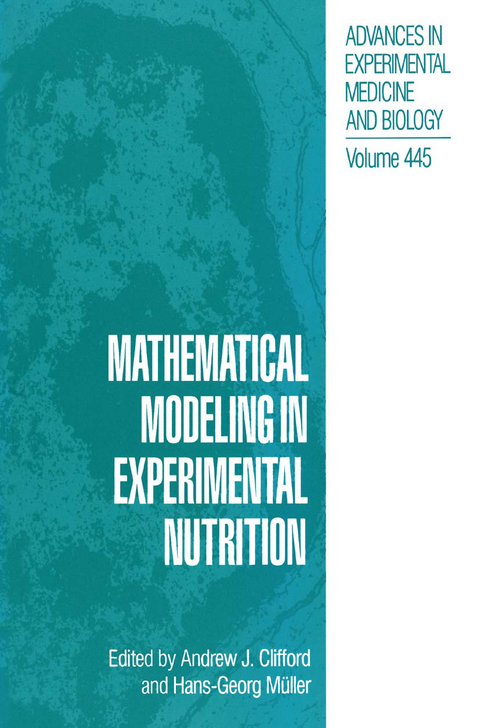
Mathematical Modeling in Experimental Nutrition
Springer-Verlag New York Inc.
978-1-4899-1961-8 (ISBN)
Nutrients have been recognized as essential for maximum growth, successful reproduction, and infection prevention since the 1940s; since that time, the lion's share of nutrient research has focused on defining their role in these processes. Around 1990, however, a major shift began in the way that researchers viewed some nutrients particularly the vitamins. This shift was motivated by the discovery that modest declines in vitamin nutritional status are associated with an increased risk of ill-health and disease (such as neural tube defects, heart disease, and cancer), especially in those populations or individuals who are genetically predisposed. In an effort to expand upon this new understanding of nutrient action, nutritionists are increasingly turning their focus to the mathematical modeling of nutrient kinetic data. The availability of suitably-tagged (isotope) nutrients (such as B-carotene, vitamin A, folate, among others), sensitive analytical methods to trace them in humans (mass spectrometry and accelerator mass spectrometry), and powerful software (capable of solving and manipulating differential equations efficiently and accurately), has allowed researchers to construct mathematical models aimed at characterizing the dynamic and kinetic behavior of key nutrients in vivo in humans at an unparalleled level of detail.
I. Theoretical Considerations in Compartmental Modeling.- 1. Balancing Needs, Efficiency, and Functionality in the Provision of Modeling Software: A Perspective of the NIH WinSAAM Project.- 2. Compartmental Modeling of Human Lactation.- 3. Modeling Protein Turnover.- 4. Developing and Testing Integrated Multicompartmental Models to Describe a Single-Input Multiple-Output Study Using the SAAM II Software System.- 5. Compartmental Models: Theory and Practice Using the SAAM II Software System.- 6. Approaches to Population Kinetic Analysis with Application to Metabolic Studies.- 7. The Mathematics behind Modeling.- 8. Distributing Working Versions of Published Mathematical Models for Biological Fields via the Internet.- II. Statistical Modeling in Nutrition.- 9. Measurement Error and Dietary Intake.- 10. Statistical Models for Quantitative Bioassay.- 11. Statistical Issues in Assay Development and Use.- 12. Statistical Tools for the Analysis of Nutrition Effects on the Survival of Cohorts.- III. Applications of Modeling.- 13. Development of a Compartment Model Describing the Dynamics of Vitamin A Metabolism in Men.- 14. Compartmental Models of Vitamin A and ?-Carotene Metabolism in Women.- 15. The Dynamics of Folic Acid Metabolism in an Adult Given a Small Tracer Dose of 14C-Folic Acid.- 16. Human Zinc Metabolism: Advances in the Modeling of Stable Isotope Data.- 17. Key Features of Copper versus Molybdenum Metabolism Models in Humans.- 18. Insights into Bone Metabolism from Calcium Kinetic Studies in Children.- 19. Modeling of Energy Expenditure and Resting Metabolic Rate during Weight Loss in Humans.- 20. Development and Application of a Compartmental Model of 3-Methyhistidine Metabolism in Humans and Domestic Animals.- 21. Modeling Ruminant Digestion and Metabolism.-22. Designing a Radioisotope Experiment Using a Dynamic, Mechanistic Model of Protein Turnover.- IV. Chemical / Physical Analytical Methods.- 23. Protocol Development for Biological Tracer Studies.- 24. Plasma Source Mass Spectrometry in Experimental Nutrition.- 25. Accelerator Mass Spectrometry as a Bioanalytical Tool for Nutrition Research.
| Reihe/Serie | Advances in Experimental Medicine and Biology ; 445 |
|---|---|
| Zusatzinfo | XII, 426 p. |
| Verlagsort | New York |
| Sprache | englisch |
| Maße | 155 x 235 mm |
| Themenwelt | Medizin / Pharmazie ► Gesundheitsfachberufe ► Diätassistenz / Ernährungsberatung |
| Naturwissenschaften ► Biologie ► Biochemie | |
| Naturwissenschaften ► Physik / Astronomie ► Angewandte Physik | |
| ISBN-10 | 1-4899-1961-9 / 1489919619 |
| ISBN-13 | 978-1-4899-1961-8 / 9781489919618 |
| Zustand | Neuware |
| Haben Sie eine Frage zum Produkt? |
aus dem Bereich


